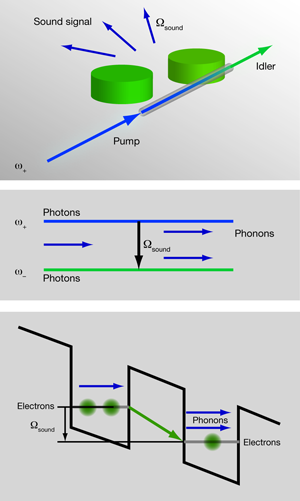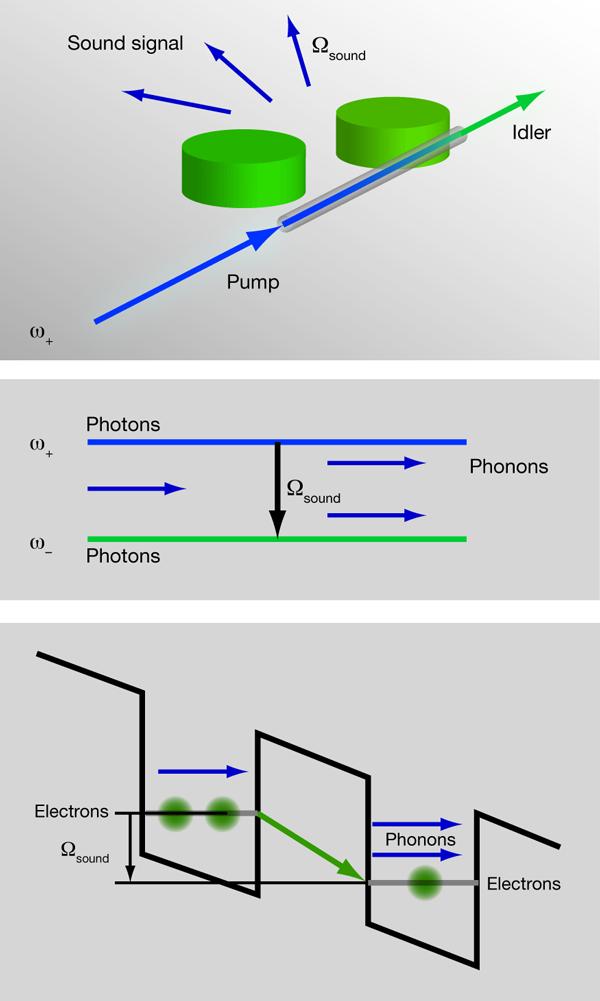Phonon lasers gain a sound foundation
Electromagnetic waves and sound waves have an obvious resemblance, and the concepts and techniques used in optics are often brought into the acoustic domain and vice versa. One can immediately think of the obvious correspondences between acoustic and optical microscopes, between radar and sonar, and such concepts as electrical and acoustic impedances, all of which highlight this “son et lumière” similarity. Using the language of classical physics, this similarity is a consequence of the fact that the same wave equation governs oscillations of atoms, ions, and molecules in a sound wave and the oscillation of electrical and magnetic fields in an optical wave. And in the language of modern quantum physics the basic quanta of light (photons) and sound (phonons) obey the same rules describing all bosons—particles with integer spin. The most striking consequence of the quantum nature of light is the ability of matter to emit coherent photons of identical frequencies and phases, a process predicted in 1917 by Albert Einstein, who called it “stimulated emission.” This was realized 50 years ago, when the first optical laser was demonstrated [1].
After that groundbreaking discovery, the concept of a “phonon laser” in which coherent phonons can be amplified by stimulated emission has been on the minds of many researchers. The benefits of such sources are easy to grasp: since sound waves propagate at a speed that is about five orders of magnitude less than speed of light, the wavelength of sound waves is correspondingly shorter than that of light waves of the same frequency, and thus one can perform highly precise nondestructive measurements and imaging, as well as achieve high concentration of energy using focused sound waves. Conventional sources of sound waves, such as piezoelectric transducers, do not operate efficiently above few tens of gigahertz, hence a phonon laser would be of great interest to the scientific community. Now, as reported in Physical Review Letters, two groups—Ivan Grudinin, Hansuek Lee, Oskar Painter, and Kerry Vahala at the California Institute of Technology in the US [2], and Ryan Beardsley, Andrey Akimov, Mohamed Henini, and Anthony Kent at the University of Nottingham in the UK [3]—both report dramatic progress.
Despite all the similarities between photons and phonons, no phonon lasers have been developed up until now. The difficulty, ironically, can be traced to the same fact that makes phonon lasers so desirable [4]—the comparatively short wavelength of sound, which causes spontaneous emission processes to dominate over stimulated emission unless one modifies the density of phonon states by employing high-quality acoustic resonators.
This is precisely the approach taken by the group at Caltech who have demonstrated the first unambiguous evidence of optically pumped phonon lasing in the coupled whispering-gallery mode (WGM) optical resonators [2]. In a conventional laser, stimulated emission occurs from upper to lower states of the atoms and ions, while in the Caltech design these states are those of phonons confined in two coupled silica microtoroid WGM resonators (Fig. 1, top). This arrangement allows one to tune the frequency separation between the upper and lower states to that of an acoustic resonance of the system. Under this resonance condition, when the upper state is populated with a sufficient number of photons coming from the pump laser via the optical fiber, these photons begin to split into the lower frequency photons of the lower state and the coherent phonons at the Ωsound=21MHz frequency (Fig 1, center). These vibrations are picked up optically and the “hockey-stick-like” dependence of their power on pump power shows unmistakable evidence of the onset of stimulated emission, also known as the lasing threshold. Phonon lasing is further confirmed by the narrowing of the spectrum of mechanical vibrations.
Only bosons are involved in the phonon lasing, so it can also be interpreted as a three-wave parametric process in which two waves (the “pump” and the “idler” in the jargon of the field) are optical, and the third one (the “signal”) is acoustic. This can also be viewed as stimulated Brillouin scattering—an inelastic collision in which a photon is converted to a downshifted photon and a phonon with energy equal to the difference is emitted. But it is important that the threshold is achieved when the phonon gain surpasses the phonon loss, in contrast to Brillouin or Raman lasers in which the threshold is achieved when the photon gain supersedes photon loss and the coherent phonons are no more than a byproduct. In this sense, the Caltech device is a true phonon laser.
While the Caltech group has used the transitions between two photon states as a source of coherent phonons, the group at Nottingham [3] used a different strategy to achieve the evidence of coherent phonon amplification in the THz range. This is a “sound” with a pitch 15 octaves higher than that of the acoustic wave in the Caltech experiment. Their device bears resemblance to the quantum cascade laser [5] in which an electron cascades down a staircase of energy states in a biased semiconductor superlattice, releasing the accumulated energy in the form of coherent photons in the infrared or THz range. The Nottingham group uses a similar arrangement (Fig.1, bottom) in which the electrons tunnel from one semiconductor quantum well to the next, with each step releasing a half- THz acoustic phonon to satisfy energy conservation. The mechanism coupling electrons and phonons is essentially the same one that causes resistance in electronic devices, but here this mechanism is put into productive use. Normally this process occurs spontaneously and the emitted phonons have all different phases and directions. But in the presence of a strong coherent phonon wave, the stimulated process ensues and the phonon wave becomes amplified.
The Nottingham researchers have used a strong laser pulse to both generate and detect the THz acoustic waves, and have demonstrated marked increase in the power of THz waves when the superlattice is electrically biased and the electrons start cascading down emitting coherent phonons to amplify the wave. While so far, only amplification and not lasing has been achieved, one can expect that oscillation can be attained when the resonant phonon reflectors are incorporated into the structure.
The impressive results demonstrated by these two groups portend the advent of versatile sources of coherent acoustic waves in a wide range of frequencies with applications in imaging, nondestructive evaluation, and medicine, as well as in other yet unexplored fields.
References
- T. Maiman, Nature 187, 493 (1960)
- I. S. Grudinin, H. Lee, O. Painter, and K. J. Vahala, Phys. Rev. Lett. 104, 083901 (2010)
- R. P. Beardsley, A. V. Akimov, M. Henini, and A. J. Kent, Phys. Rev. Lett. 104, 085501 (2010)
- J. Chen and J. B. Khurgin, IEEE J. Quantum Elect. 39, 600 (2003)
- J. Faist, F. Capasso, D. L. Sivco, C. Sirtori, A. L. Hutchinson, and A. Y. Cho, Science 264, 553 (1994)





